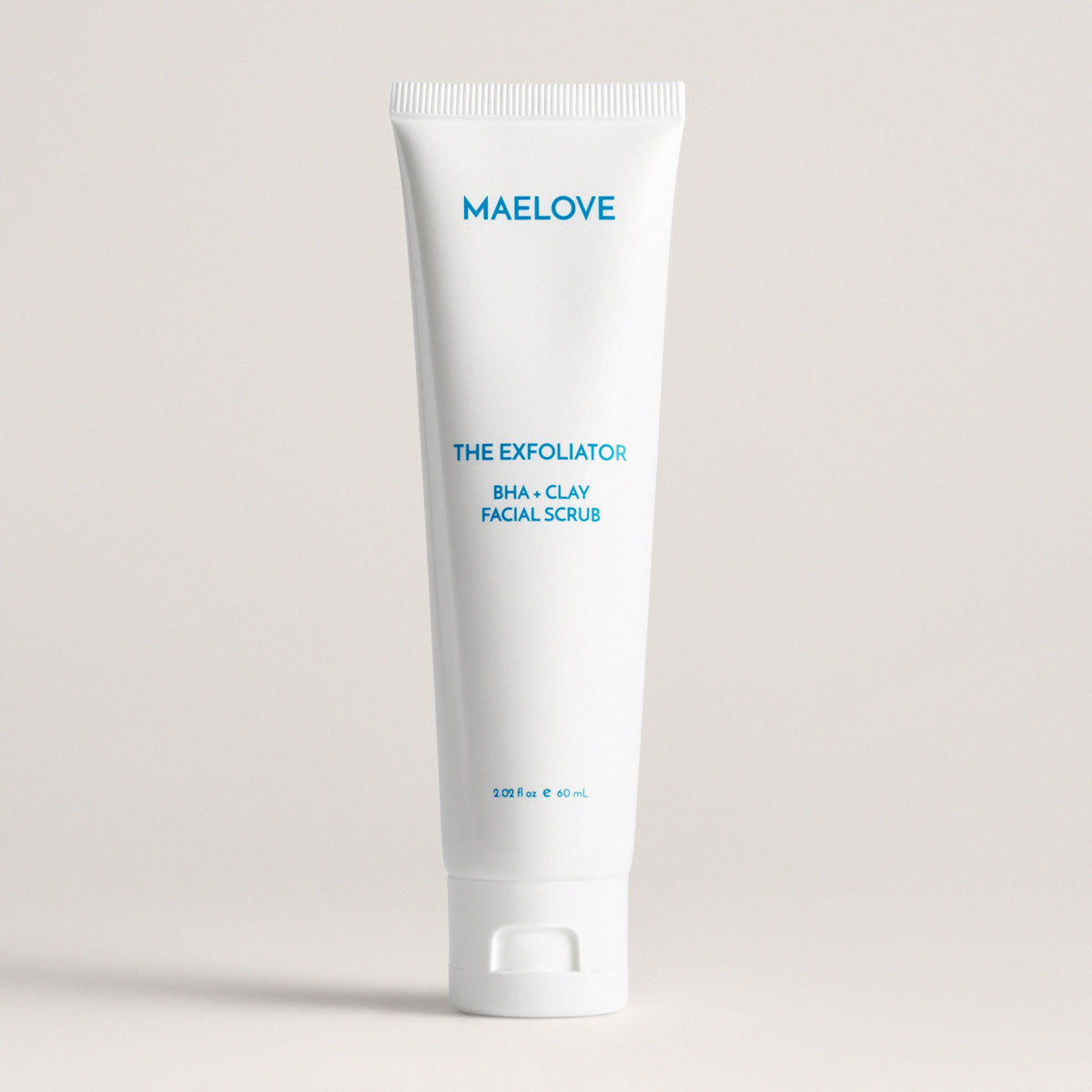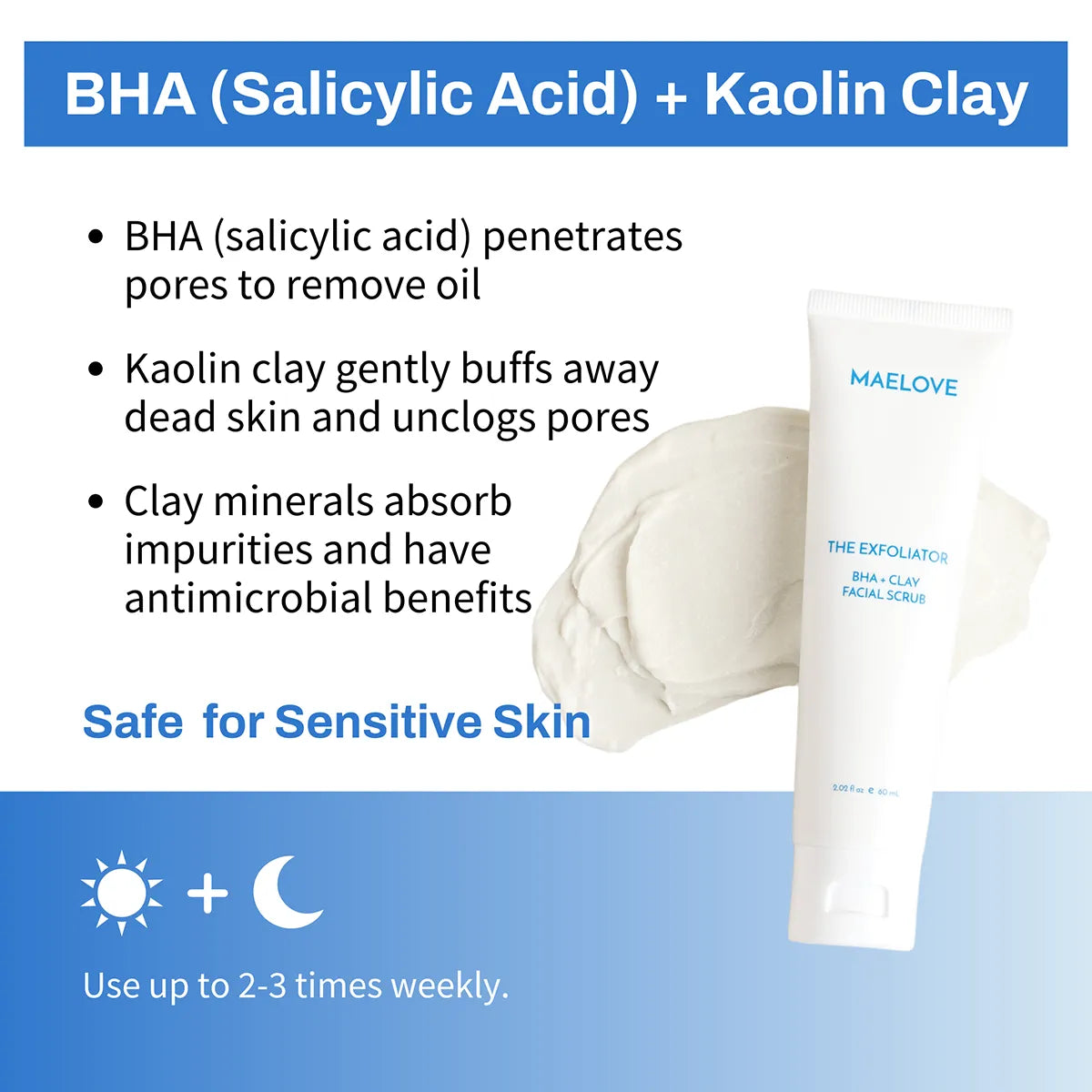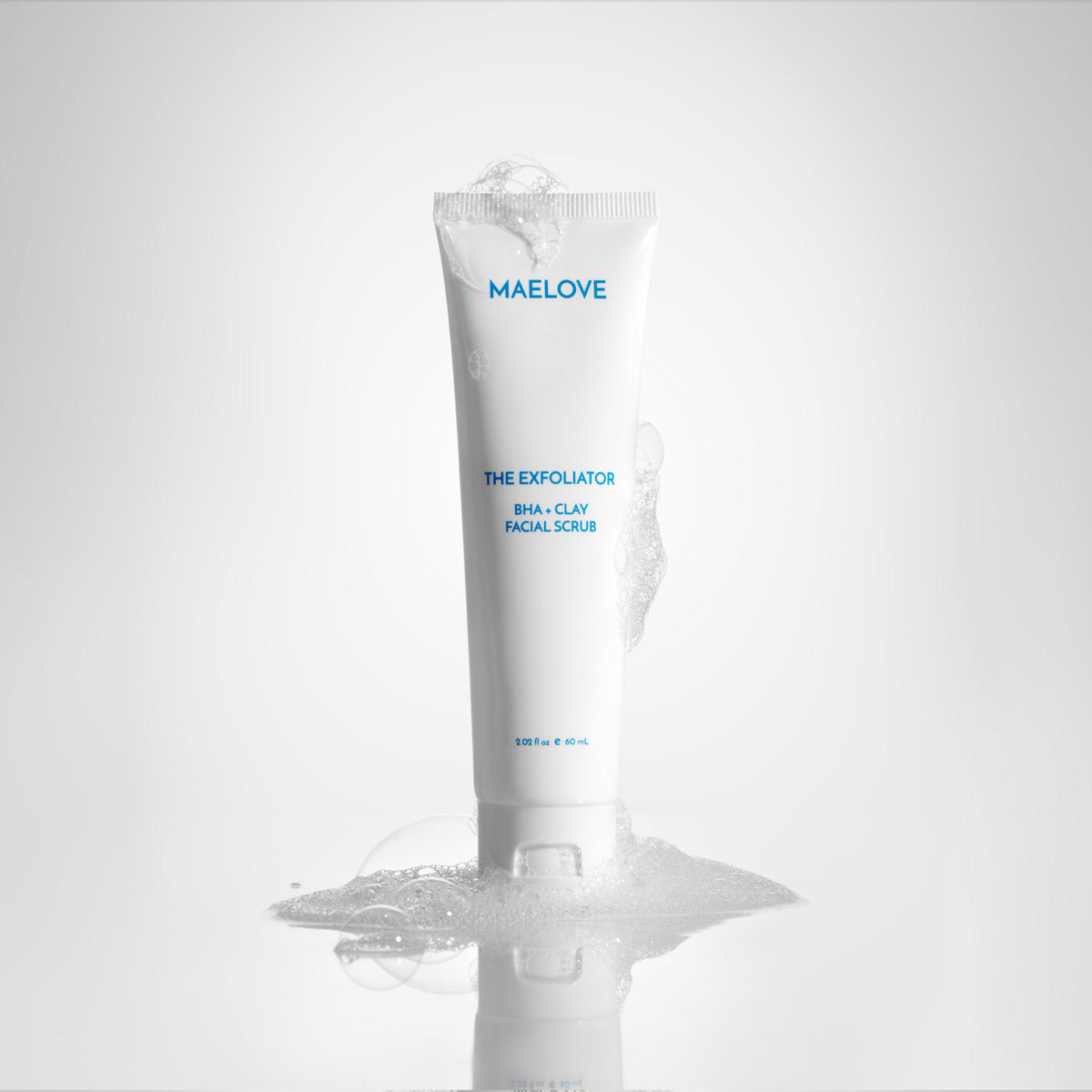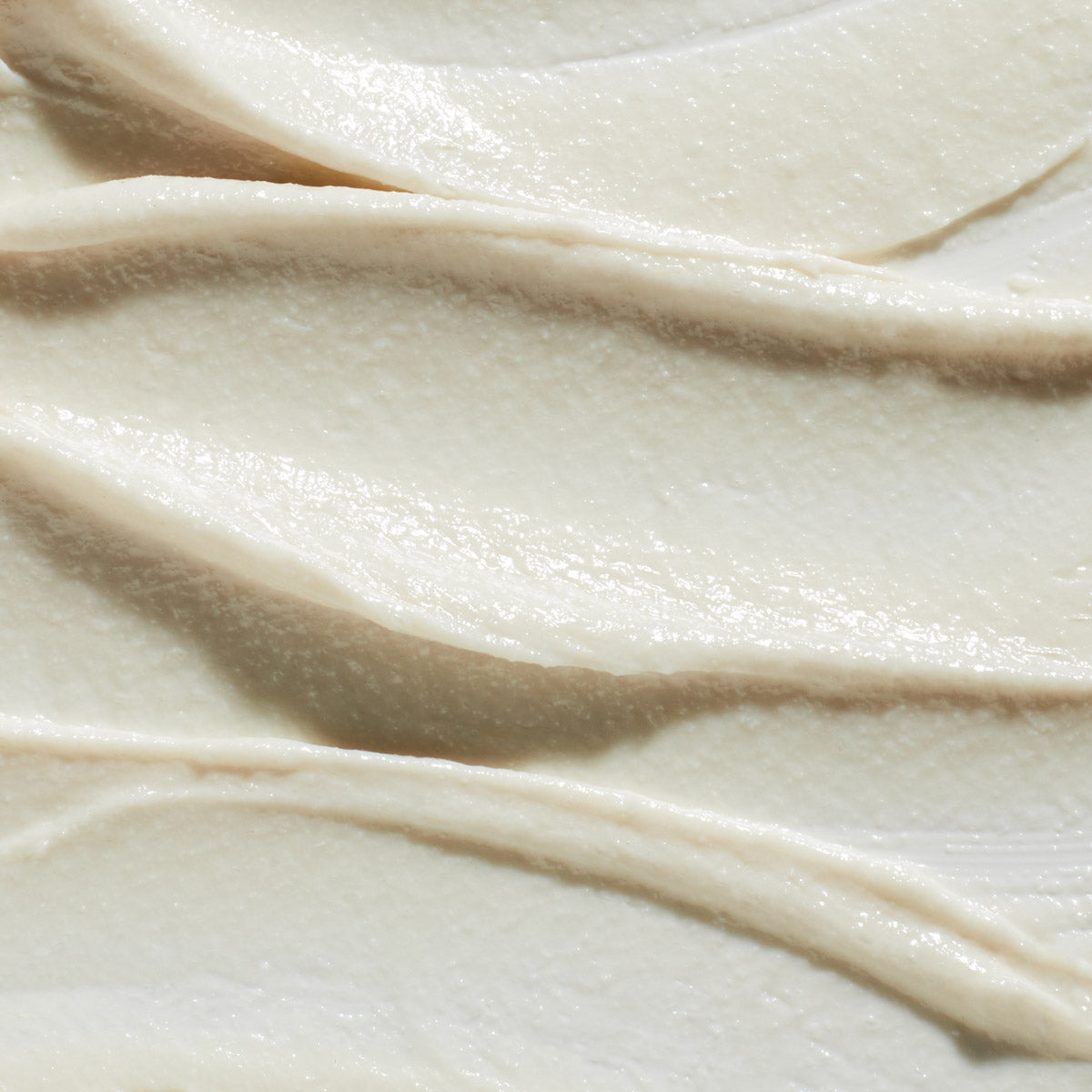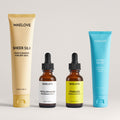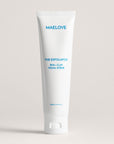
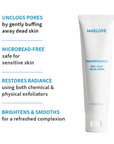

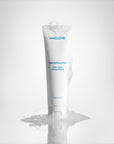
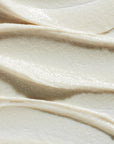
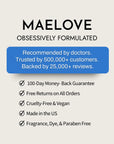
The Exfoliator BHA + Clay Facial Scrub
Most orders are processed and shipped within two business days (Mon - Fri). You’ll receive an email with tracking details as soon as yours is on its way.
For US-based shoppers, shipping is on us for orders $50 and over. Anything less is a flat $6.95 charge.
100-Day Peace of Mind: Skincare is a journey, and we're with you. You have a full 100 days to try your products. If you aren't satisfied, returns are free and easy through our self-serve portal or a quick note to team@maelove.com
Immediately:
- Your skin feels "deep cleaned" and touchably soft. The fine polish buffs away flakes for a smooth finish without any tight or stripped sensation.
Weeks 2-4:
- You’ll notice better surface clarity. Rough patches soften, and your skin looks more refreshed and "awake" as your serums begin to absorb more effectively.
Weeks 4 and beyond:
- Steady use helps clear congested pores and reduces the look of surface bumps. Your tone appears more even and bright.
Immediate softness is just the start, and the best results come from playing the long game. Because the benefits are cumulative, your skin looks its best when you’re consistent.


Dual-action exfoliation designed so your sensitive skin can handle it.
PORE-CLEARING TRIO (Salicylic Acid, Kaolin Clay, Diatomaceous Earth)
- Deep-cleans your pores while gently buffing away rough patches. You get a smooth, refined surface without the harshness of old-school scrubs.
CALM & COMFORT BLEND (Niacinamide, Allantoin, Glycerin, Honeysuckle)
- Helps keep your skin balanced and comfortable during exfoliation, so you never feel tight or stripped.
Use 1–3 times weekly for best results.
Wet face and gently massage gently onto skin using circular motions Don't scrub hard. Be gentle.
Wash off thoroughly with water. Wash off thoroughly. Follow with your favorite serum to lock in smoothness.
See our How to Layer guide for tips on layering multiple Maelove products.
Customer Reviews
For the Curious
Aqua (Water), Glycerin, Cellulose Acetate, Diatomaceous Earth, Caprylic/Capric Triglyceride, Behenyl Alcohol, Kaolin, Niacinamide, Allantoin, Salicylic Acid, Tocopheryl Acetate (D-alpha), Passiflora Incarnata (Passion Flower) Flower Extract, Hamamelis Virginiana (Witch Hazel) Water, Titanium Dioxide, Stearic Acid, Phytic Acid, Lonicera Caprifolium (Honeysuckle) Flower Extract, Lonicera Japonica (Honeysuckle) Flower Extract, Dimethicone, Citric Acid, Cetyl Alcohol, Sucrose Stearate, Glycol Distearate, Potassium Sorbate, Caprylyl Glycol, Phenethyl Alcohol, Sodium Stearoyl Glutamate, Trisodium Ethylenediamine Disuccinate, Xanthan Gum, Dicaprylyl Ether, Citrus Reticulata (Tangerine) Peel Oil, Carbomer, Alcohol
Since ancient times, exfoliants have been used to improve skin youth and vigor. In modern times, chemical exfoliants in the form of hydroxy acids, and physical exfoliants that mechanically exfoliate dead skin cells have emerged as the prime means by which the natural process of skin renewal can be complemented (Kornhauser et al. 2010).
In younger adults, the skin's outer layer fully renews about every month. However, as we age, this rate can slow down by up to 50%, and the skin's natural shedding process diminishes. This build-up of dead skin cells can cause the skin to appear more uneven and lackluster, make pores seem enlarged, and highlight wrinkles more prominently (Rodan et al. 2016).
Regular exfoliation can instantly unveil a more radiant, smooth, and youthful complexion. Moreover, exfoliants aid in clearing blocked pores, which can alleviate acne concerns. Clay-based scrubs are beneficial in absorbing excess sebum and impurities, ensuring the skin remains clear and purified. Consistent exfoliation can also kickstart the skin's revitalization process which mimics the renewal process in younger skin (Kornhauser et al. 2010).
Hydroxy acids are the main chemical exfoliants as they loosen cell to cell adhesions between dead skin cells allowed for easier removal. Beta hydroxy acid (BHA) salicylic acid in particular is widely used due to the fact that it is fat-soluble and able to penetrate deep into the pores of the skin which are full of sebum. Sebum is an oily substance secreted by sebaceous glands in your skin located within the pores. While sebum is useful in helping the skin be waterproof, it can also accumulate in the pores collecting dirt, pollutants and dead skin cells, ultimately clogging the pore and leading to the formation of acne. Salicylic acid can help unclog pores helping keep skin clear and clean and is often used in the treatment of acne (Kornhauser et al. 2010).
The key benefit to mechanical exfoliation is that results are instant. By rubbing physical exfoliators across the face in circular motions, dead skin cells are gently buffed off. In the past, harsh exfoliating scrubs have employed microbeads or large particles that could lead to micro-tears and skin damage, increasing redness or acne breakouts (AAD). In recent times, gentle mechanical exfoliants such as pulverized kaolin clay and diatomaceous earth have been employed to safely exfoliate skin with very fine particles. Further, clay minerals such as kaolin in particular are considered effective cleansing agents as they can absorb excess oils and impurities, as well as having antimicrobial activity (Awad et al. 2017, Gubitosa et al. 2019).
Please consult your doctor before using this product while pregnant. While the CIR states up to 2% salicylic acid is safe to use while pregnant, some doctors may say to avoid it altogether as high concentrations of salicylic acid are harmful to the developing fetus (Chien et al. 2016). It is recommended to discontinue use of this product while nursing. At Maelove, we recommend that you first speak with your doctor about this ingredient to get their opinion. Please check out our extended writeup on how to treat acne while pregnant.
Kornhauser A, Coelho SG, Hearing VJ (2010). “Application of hydroxy acids: classification, mechanisms, and photoactivity.” Clinical, Cosmetic and Investigational Dermatology. 3: 135-142.
Rodan K, Fields K, Majewski G, Falla T (2016). “Skincare Bootcamp: The evolving role of skincare.” Plast Reconstr Surg Glob Open: e1152. Doi:10.1097/GOX.0000000000001152.
Kornhauser A, Coelho SG, Hearing VJ (2010). “Application of hydroxy acids: classification, mechanisms, and photoactivity.” Clinical, Cosmetic and Investigational Dermatology. 3: 135-142.
American Academy of Dermatology Association. “How to safely exfoliate at home”. https://www.aad.org/public/everyday-care/skin-care-secrets/routine/safely-exfoliate-at-home
Awad ME, Lopez-Galindo A, Setti M, El-Rahmany MM, Iborra CV. “Kaolinite in pharmaceutics and biomedicine.” Int J Pharm 25:533(1): 34-48.
Gubitosa J, Rizzi V, Fini P, Cosma P (2019). “Hair Care Cosmetics: From Traditional Shampoo to Solid Clay and Herbal Shampoo, A Review.” Cosmetics. 6(13): doi: 10.3390/cosmetics6010013.
Chien AL, Rainer B, Sachs DL, Helfrich YR (2016). “Treatment of Acne in Pregnancy.” J Am Board Fam Med. 29: 254-262.

Today we address the question, are there ways to shrink my pores? Even though your pore size is largely genetically determined (Flament et al. 2015), so there isn’t a...
